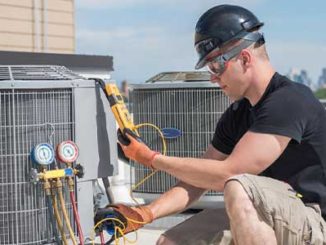
By / Peter Boileau • Chairperson, SMACNA-Western Washington Technical Committee
The SMACNA-Western Washington Code and Technical Committee regrouped earlier this year following a COVID-19 pause. We picked up where we left off in February 2020 to conclude our review of the 2018 Washington State Commercial Energy Code, which has now been adopted. In the committee’s opinion, the following paragraphs describe the code sections of the most interest to SMACNA members and that have major revisions under this new code. Our review and commentary below are the opinion of our committee team members, who are a mix of design professionals, contractors, and code officials. Your interpretation of these code revisions, as well as the opinion of your local code authority partners, may differ, so keep this in mind as you incorporate these code changes into your projects.
The committee previously addressed 2018 code sections C102, C104, C106, C402.1, and C402.5.3. Following detailed discussion on the balance of code section changes, I will provide a summary of significant revisions to watch and plan for in your current and future projects.
Section C403.8 Fan and Fan Controls: This section has been revised (and relocated from Section 403.2 in the 2015 code) in the continuing effort to limit the use of large horsepower fan systems in most building types. The committee understands that recent and current energy codes are favoring the use of hydronic systems instead of air systems to convey heating and cooling in buildings and believe that language in this section eliminates (or nearly eliminates) large high pressure-class systems from current code compliant design and installation.
Section C403.9 Heat Rejection and Heat Recovery Equipment: This section now has added requirements for both fan speed control and variable fluid flow control for all heat rejection equipment, including condensing units and cooling towers with combined motor horsepower equal to or greater than 5 hp. The committee believes that these requirements are reasonable and in line with variable motor control requirements found in other sections of this code.
Section 406 Efficiency Measures: In the 2015 code, this section provided guidelines for a “prescriptive path” to compliance with the code. The 2018 code has added complexities to this prescriptive path, which in many cases will require some form of energy modeling to prove compliance with this code.
The 2015 code required selecting two of the eight listed “additional package efficiency options” from the prescriptive table. Each option was equally weighted and not dependent on building type. The 2018 code requires achieving six points from twelve categories in the “efficiency credits package table” and the points achieved are variable based on building type.
The 2018 code emphasizes the use of dedicated outdoor air systems (DOAS) with energy recovery for many types of buildings and occupancies. The use of high efficiency VAV systems is still viable but likely will be further restricted or not be allowed in future code editions unless this type of system can be shown to use equal or less energy as compared to a similarly sized hydronic system with DOAS ventilation.
Section C407 Total Building Performance: This section describes requirements to meet the code via “total building performance” based on the creation of an energy model that compares your specific project and its associated building characteristics to a code baseline model to show compliance.
The 2015 code allowed the use of C406 additional package efficiency options when using the C407 approach to help prove compliance using this path. This is no longer allowed in the 2018 code as the new code now requires that your specific project be compared to a model based on ASHRAE Standard 90.1 Appendix G “Performance Rating Method” with an additional “Carbon Emissions Factor” calculation requirement. This is the first time that the Washington State Energy code has required proof of carbon emissions reduction in addition to energy savings and is therefore a significant change in the methodology used to comply with the code via the C407 path. This new methodology also limits the ability to trade energy efficient components (e.g., more efficient mechanical systems for a less efficient envelope) for code compliance. This change does make our job as mechanical designers/contractors easier in one respect, as it puts more onus on the architect to develop a stand-alone code compliant envelope without much reliance on mechanical system efficiencies to offset things like large glazing percentages that we have typically seen in the past.
There is a third option to comply with the 2018 energy code. It is by the use of a “Target Compliance Path” methodology. Using this option, an energy use target is agreed to for a specific building project, and it is incumbent on the building’s owners to prove that annual energy use is at or below the target. Proof of compliance is in the form of utility billings, and this proof must be submitted for several years after occupancy. If the building fails to meet target energy goals, the building owner is liable for significant fines (or worse, even condemnation) from the jurisdiction that granted the permit. This approach is currently seen by many developers as both burdensome and too risky. Caution should be used if considering the use of this compliance path with your customer.
In summary, the 2015 is a continuation of the State of Washington’s pursuit to meet their stated goal of new buildings being carbon neutral by 2030 while at the same time using 10% of the energy as compared to similar buildings in 1998 when the first energy code was established in this state. In order to push forward with these goals, the 2018 code continues to demand the construction of better envelopes, more efficient (and less) glazing in buildings, and overall tighter construction to eliminate infiltration. In addition, the new code is focusing on use of smaller energy recovery DOAS and Energy Recovery Ventilation (ERV) systems in lieu of larger fan systems with economizer cooling. And finally, the most significant change to the 2018 energy code is the move away from natural gas and electric resistance heating equipment in favor of using heat-pump technology (this is already codified in the 2018 Seattle Energy Code). We can be assured that in future codes, natural gas and electric resistance energy will be no longer be allowed, and the use of heat-pumps for building heating, cooling, and domestic hot water generation will be the new baseline for the projects we build. ■



